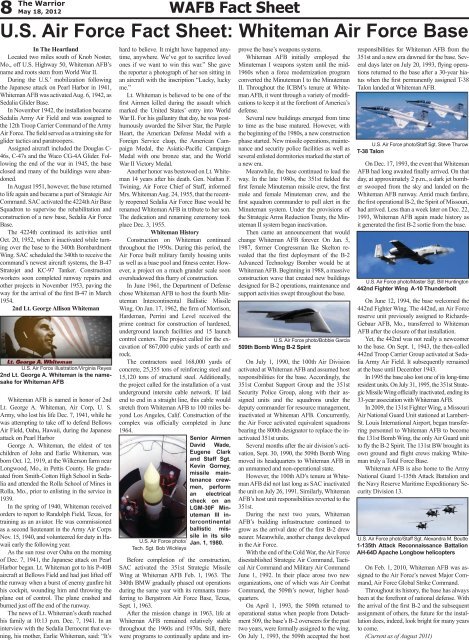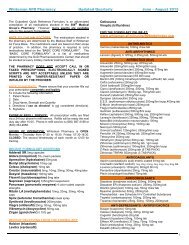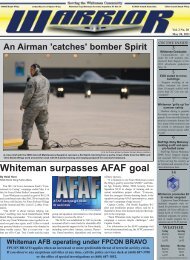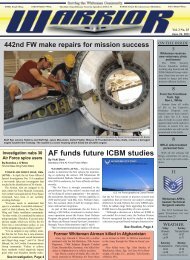Weather 3 5 8-9 - Whiteman Air Force Base
Weather 3 5 8-9 - Whiteman Air Force Base
Weather 3 5 8-9 - Whiteman Air Force Base
Create successful ePaper yourself
Turn your PDF publications into a flip-book with our unique Google optimized e-Paper software.
The Warrior<br />
8 May 18, 2012<br />
In The Heartland<br />
Located two miles south of Knob Noster,<br />
Mo., off U.S. Highway 50, <strong>Whiteman</strong> AFB’s<br />
name and roots stem from World War II.<br />
During the U.S.’ mobilization following<br />
the Japanese attack on Pearl Harbor in 1941,<br />
<strong>Whiteman</strong> AFB was activated Aug. 6, 1942, as<br />
Sedalia Glider <strong>Base</strong>.<br />
In November 1942, the installation became<br />
Sedalia Army <strong>Air</strong> Field and was assigned to<br />
the 12th Troop Carrier Command of the Army<br />
<strong>Air</strong> <strong>Force</strong>. The field served as a training site for<br />
glider tactics and paratroopers.<br />
Assigned aircraft included the Douglas C-<br />
46s, C-47s and the Waco CG-4A Glider. Following<br />
the end of the war in 1945, the base<br />
closed and many of the buildings were abandoned.<br />
In August 1951, however, the base returned<br />
to life again and became a part of Strategic <strong>Air</strong><br />
Command. SAC activated the 4224th <strong>Air</strong> <strong>Base</strong><br />
Squadron to supervise the rehabilitation and<br />
construction of a new base, Sedalia <strong>Air</strong> <strong>Force</strong><br />
<strong>Base</strong>.<br />
The 4224th continued its activities until<br />
Oct. 20, 1952, when it inactivated while turning<br />
over the base to the 340th Bombardment<br />
Wing. SAC scheduled the 340th to receive the<br />
command’s newest aircraft systems, the B-47<br />
Stratojet and KC-97 Tanker. Construction<br />
workers soon completed runway repairs and<br />
other projects in November 1953, paving the<br />
way for the arrival of the first B-47 in March<br />
1954.<br />
2nd Lt. George Allison <strong>Whiteman</strong><br />
<strong>Whiteman</strong> AFB is named in honor of 2nd<br />
Lt. George A. <strong>Whiteman</strong>, <strong>Air</strong> Corp, U. S.<br />
Army, who lost his life Dec. 7, 1941, while he<br />
was attempting to take off to defend Bellows<br />
<strong>Air</strong> Field, Oahu, Hawaii, during the Japanese<br />
attack on Pearl Harbor<br />
George A. <strong>Whiteman</strong>, the eldest of ten<br />
children of John and Earlie <strong>Whiteman</strong>, was<br />
born Oct. 12, 1919, at the Wilkerson farm near<br />
Longwood, Mo., in Pettis County. He graduated<br />
from Smith-Cotton High School in Sedalia<br />
and attended the Rolla School of Mines in<br />
Rolla, Mo., prior to enlisting in the service in<br />
1939.<br />
In the spring of 1940, <strong>Whiteman</strong> received<br />
orders to report to Randolph Field, Texas, for<br />
training as an aviator. He was commissioned<br />
as a second lieutenant in the Army <strong>Air</strong> Corps<br />
Nov. 15, 1940, and volunteered for duty in Hawaii<br />
early the following year.<br />
As the sun rose over Oahu on the morning<br />
of Dec. 7, 1941, the Japanese attack on Pearl<br />
Harbor began. Lt. <strong>Whiteman</strong> got to his P-40B<br />
aircraft at Bellows Field and had just lifted off<br />
the runway when a burst of enemy gunfire hit<br />
his cockpit, wounding him and throwing the<br />
plane out of control. The plane crashed and<br />
burned just off the end of the runway.<br />
The news of Lt. <strong>Whiteman</strong>’s death reached<br />
his family at 10:13 p.m. Dec. 7, 1941. In an<br />
interview with the Sedalia Democrat that evening,<br />
his mother, Earlie <strong>Whiteman</strong>, said: “It’s<br />
WAFB Fact Sheet<br />
U.S. <strong>Air</strong> <strong>Force</strong> Fact Sheet: <strong>Whiteman</strong> <strong>Air</strong> <strong>Force</strong> <strong>Base</strong><br />
U.S. <strong>Air</strong> <strong>Force</strong> illustration/Virginia Reyes<br />
2nd Lt. George A. <strong>Whiteman</strong> is the namesake<br />
for <strong>Whiteman</strong> AFB<br />
hard to believe. It might have happened anytime,<br />
anywhere. We’ve got to sacrifice loved<br />
ones if we want to win this war.” She gave<br />
the reporter a photograph of her son sitting in<br />
an aircraft with the inscription “Lucky, lucky<br />
me.”<br />
Lt. <strong>Whiteman</strong> is believed to be one of the<br />
first <strong>Air</strong>men killed during the assault which<br />
marked the United States’ entry into World<br />
War II. For his gallantry that day, he was posthumously<br />
awarded the Silver Star, the Purple<br />
Heart, the American Defense Medal with a<br />
Foreign Service clasp, the American Campaign<br />
Medal, the Asiatic-Pacific Campaign<br />
Medal with one bronze star, and the World<br />
War II Victory Medal.<br />
Another honor was bestowed on Lt. <strong>Whiteman</strong><br />
14 years after his death. Gen. Nathan F.<br />
Twining, <strong>Air</strong> <strong>Force</strong> Chief of Staff, informed<br />
Mrs. <strong>Whiteman</strong> Aug. 24, 1955, that the recently<br />
reopened Sedalia <strong>Air</strong> <strong>Force</strong> <strong>Base</strong> would be<br />
renamed <strong>Whiteman</strong> AFB in tribute to her son.<br />
The dedication and renaming ceremony took<br />
place Dec. 3, 1955.<br />
<strong>Whiteman</strong> History<br />
Construction on <strong>Whiteman</strong> continued<br />
throughout the 1950s. During this period, the<br />
<strong>Air</strong> <strong>Force</strong> built military family housing units<br />
as well as a base pool and fitness center. However,<br />
a project on a much grander scale soon<br />
overshadowed this flurry of construction.<br />
In June 1961, the Department of Defense<br />
chose <strong>Whiteman</strong> AFB to host the fourth Minuteman<br />
Intercontinental Ballistic Missile<br />
Wing. On Jan. 17, 1962, the firm of Morrison,<br />
Hardeman, Perrini and Level received the<br />
prime contract for construction of hardened,<br />
underground launch facilities and 15 launch<br />
control centers. The project called for the excavation<br />
of 867,000 cubic yards of earth and<br />
rock.<br />
The contractors used 168,000 yards of<br />
concrete, 25,355 tons of reinforcing steel and<br />
15,120 tons of structural steel. Additionally,<br />
the project called for the installation of a vast<br />
underground intersite cable network. If laid<br />
end to end in a straight line, this cable would<br />
stretch from <strong>Whiteman</strong> AFB to 100 miles beyond<br />
Los Angeles, Calif. Construction of the<br />
complex was officially completed in June<br />
1964.<br />
U.S. <strong>Air</strong> <strong>Force</strong> photo/<br />
Tech. Sgt. Bob Wickleys<br />
Senior <strong>Air</strong>men<br />
David Wade,<br />
Eugene Clark<br />
and Staff Sgt.<br />
Kevin Gorney,<br />
missile maintenancecrewmen,<br />
perform<br />
an electrical<br />
check on an<br />
LGM-30F Minuteman<br />
III intercontinental<br />
ballistic missile<br />
in its silo<br />
Jan. 1, 1980.<br />
Before completion of the construction,<br />
SAC activated the 351st Strategic Missile<br />
Wing at <strong>Whiteman</strong> AFB Feb. 1, 1963. The<br />
340th BMW gradually phased out operations<br />
during the same year with its remnants transferring<br />
to Bergstrom <strong>Air</strong> <strong>Force</strong> <strong>Base</strong>, Texas,<br />
Sept. 1, 1963.<br />
After the mission change in 1963, life at<br />
<strong>Whiteman</strong> AFB remained relatively stable<br />
throughout the 1960s and 1970s. Still, there<br />
were programs to continually update and im-<br />
prove the base’s weapons systems.<br />
<strong>Whiteman</strong> AFB initially employed the<br />
Minuteman I weapons system until the mid-<br />
1960s when a force modernization program<br />
converted the Minuteman I to the Minuteman<br />
II. Throughout the ICBM’s tenure at <strong>Whiteman</strong><br />
AFB, it went through a variety of modifications<br />
to keep it at the forefront of America’s<br />
defense.<br />
Several new buildings emerged from time<br />
to time as the base matured. However, with<br />
the beginning of the 1980s, a new construction<br />
phase started. New missile operations, maintenance<br />
and security police facilities as well as<br />
several enlisted dormitories marked the start of<br />
a new era.<br />
Meanwhile, the base continued to lead the<br />
way. In the late 1980s, the 351st fielded the<br />
first female Minuteman missile crew, the first<br />
male and female Minuteman crew, and the<br />
first squadron commander to pull alert in the<br />
Minuteman system. Under the provisions of<br />
the Strategic Arms Reduction Treaty, the Minuteman<br />
II system began inactivation.<br />
Then came an announcement that would<br />
change <strong>Whiteman</strong> AFB forever. On Jan. 5,<br />
1987, former Congressman Ike Skelton revealed<br />
that the first deployment of the B-2<br />
Advanced Technology Bomber would be at<br />
<strong>Whiteman</strong> AFB. Beginning in 1988, a massive<br />
construction wave that created new buildings<br />
designed for B-2 operations, maintenance and<br />
support activities swept throughout the base.<br />
U.S. <strong>Air</strong> <strong>Force</strong> photo/Bobbie Garcia<br />
509th Bomb Wing B-2 Spirit<br />
On July 1, 1990, the 100th <strong>Air</strong> Division<br />
activated at <strong>Whiteman</strong> AFB and assumed host<br />
responsibilities for the base. Accordingly, the<br />
351st Combat Support Group and the 351st<br />
Security Police Group, along with their assigned<br />
units and the squadrons under the<br />
deputy commander for resource management,<br />
inactivated at <strong>Whiteman</strong> AFB. Concurrently,<br />
the <strong>Air</strong> <strong>Force</strong> activated equivalent squadrons<br />
bearing the 800th designator to replace the inactivated<br />
351st units.<br />
Several months after the air division’s activation,<br />
Sept. 30, 1990, the 509th Bomb Wing<br />
moved its headquarters to <strong>Whiteman</strong> AFB in<br />
an unmanned and non-operational state.<br />
However, the 100th AD’s tenure at <strong>Whiteman</strong><br />
AFB did not last long as SAC inactivated<br />
the unit on July 26, 1991. Similarly, <strong>Whiteman</strong><br />
AFB’s host unit responsibilities reverted to the<br />
351st.<br />
During the next two years, <strong>Whiteman</strong><br />
AFB’s building infrastructure continued to<br />
grow as the arrival date of the first B-2 drew<br />
nearer. Meanwhile, another change developed<br />
in the <strong>Air</strong> <strong>Force</strong>.<br />
With the end of the Cold War, the <strong>Air</strong> <strong>Force</strong><br />
disestablished Strategic <strong>Air</strong> Command, Tactical<br />
<strong>Air</strong> Command and Military <strong>Air</strong> Command<br />
June 1, 1992. In their place arose two new<br />
organizations, one of which was <strong>Air</strong> Combat<br />
Command, the 509th’s newer, higher headquarters.<br />
On April 1, 1993, the 509th returned to<br />
operational status when people from Detachment<br />
509, the base’s B-2 overseers for the past<br />
two years, were formally assigned to the wing.<br />
On July 1, 1993, the 509th accepted the host<br />
responsibilities for <strong>Whiteman</strong> AFB from the<br />
351st and a new era dawned for the base. Several<br />
days later on July 20, 1993, flying operations<br />
returned to the base after a 30-year hiatus<br />
when the first permanently assigned T-38<br />
Talon landed at <strong>Whiteman</strong> AFB.<br />
U.S. <strong>Air</strong> <strong>Force</strong> photo/Staff Sgt. Steve Thurow<br />
T-38 Talon<br />
On Dec. 17, 1993, the event that <strong>Whiteman</strong><br />
AFB had long awaited finally arrived. On that<br />
day, at approximately 2 p.m., a dark jet bomber<br />
swooped from the sky and landed on the<br />
<strong>Whiteman</strong> AFB runway. Amid much fanfare,<br />
the first operational B-2, the Spirit of Missouri,<br />
had arrived. Less than a week later on Dec. 22,<br />
1993, <strong>Whiteman</strong> AFB again made history as<br />
it generated the first B-2 sortie from the base.<br />
U.S. <strong>Air</strong> <strong>Force</strong> photo/Master Sgt. Bill Huntington<br />
442nd Fighter Wing A-10 Thunderbolt<br />
On June 12, 1994, the base welcomed the<br />
442nd Fighter Wing. The 442nd, an <strong>Air</strong> <strong>Force</strong><br />
reserve unit previously assigned to Richards-<br />
Gebaur AFB, Mo., transferred to <strong>Whiteman</strong><br />
AFB after the closure of that installation.<br />
Yet, the 442nd was not really a newcomer<br />
to the base. On Sept. 1, 1943, the then-called<br />
442nd Troop Carrier Group activated at Sedalia<br />
Army <strong>Air</strong> Field. It subsequently remained<br />
at the base until December 1943.<br />
In 1995 the base also lost one of its long-time<br />
resident units. On July 31, 1995, the 351st Strategic<br />
Missile Wing officially inactivated, ending its<br />
33-year association with <strong>Whiteman</strong> AFB.<br />
In 2009, the 131st Fighter Wing, a Missouri<br />
<strong>Air</strong> National Guard Unit stationed at Lambert-<br />
St. Louis International <strong>Air</strong>port, began transferring<br />
personnel to <strong>Whiteman</strong> AFB to become<br />
the 131st Bomb Wing, the only <strong>Air</strong> Guard unit<br />
to fly the B-2 Spirit. The 131st BW brought its<br />
own ground and flight crews making <strong>Whiteman</strong><br />
truly a Total <strong>Force</strong> <strong>Base</strong>.<br />
<strong>Whiteman</strong> AFB is also home to the Army<br />
National Guard 1-135th Attack Battalion and<br />
the Navy Reserve Maritime Expeditionary Security<br />
Division 13.<br />
U.S. <strong>Air</strong> <strong>Force</strong> photo/Staff Sgt. Alexandra M. Boutte<br />
1-135th Attack Reconnaissance Battalion<br />
AH-64D Apache Longbow helicopters<br />
On Feb. 1, 2010, <strong>Whiteman</strong> AFB was assigned<br />
to the <strong>Air</strong> <strong>Force</strong>’s newest Major Command,<br />
<strong>Air</strong> <strong>Force</strong> Global Strike Command.<br />
Throughout its history, the base has always<br />
been at the forefront of national defense. With<br />
the arrival of the first B-2 and the subsequent<br />
assignment of others, the future for the installation<br />
does, indeed, look bright for many years<br />
to come.<br />
(Current as of August 2011)









